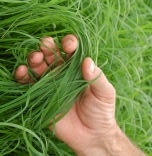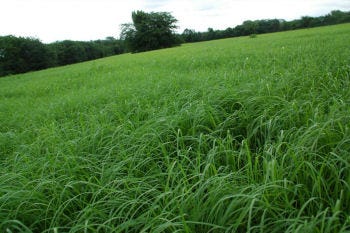
In the special Hay and Forage section of the June Missouri Ruralist, I reported on how we are experimenting with teff on our home farm in northwest Missouri. In our search for an alternative hay crop last year, we tried this small-seeded annual grass that originated in Africa. This perked the interest of several farmers, who asked that I provide some progress reports and photos on the Web site this summer.
We learned some lessons in growing about 12 acres of the crop last year, and were excited enough about the potential that we seeded 20 acres of Tiffany teff on May 20, using a light tillage method. The difference between no-till planting and light tillage is amazing.

Tiffany teff stand on June 20 – one month after planting – on Houghton Farms in Caldwell County.
Here's a re-cap of our 2009 planting:
Our teff went into a field that had grown a winter crop of cereal rye, both as a cover crop and a spring forage source for spring-calving cows. We grazed it down tight in March, and disked it lightly just to take out the cow tracks and to destroy any remaining rye. In late April, we rented a Phillips rotary harrow from one of our good neighbors, and ran over the field a couple of times. That helped firm the seedbed, and set it up in ideal condition for seeding with a Brillion seeder.
We also loosened up our pocketbook and planted 10 pounds of seed per acre, as opposed to 8 pounds last year. Tiffany teff comes with a blue clay coating to help make seeding easier. At 1.3 million seeds per pound, it's tiny. We believed a 10-pound rate will give us the best chance for a uniform stand – and it did that and more.
One month after planting – on June 20 – our teff grass is off to a fast start. (See photos). We estimate its height at 12 to 14 inches. Best of all, it is a thick, uniform stand that has really choked back the weeds and prevented field erosion.
Light tillage and paying extra attention to seedbed preparation have paid off. Plentiful rainfall and warmer temperatures in June have boosted this crop, as well.
Our goal is to mow and bale our first cutting by July 4. We will then put on 30 units of nitrogen per acre after the first cutting. We will keep you posted on its progress throughout the growing season.
About the Author(s)
You May Also Like




